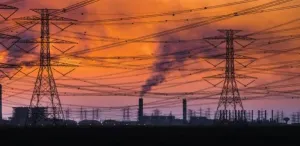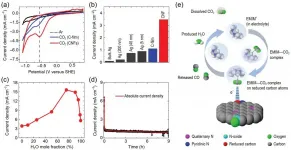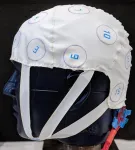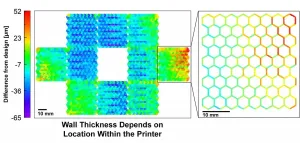https://discovery.kaust.edu.sa/en/article/1098/the-right-ring-count-to-harness-waste-heat
2021-03-17
(Press-News.org) Electronic organic materials offer promise to support alternative and green energy sources to meet escalating global energy demands and strict environmental regulations. A KAUST-led team has now developed electron-transporting, so-called n-type, organic semiconductors that could help generate electricity from waste heat released by industrial processes and homes.
Thermoelectric generators that can convert temperature changes or gradients into electricity are highly suited for harnessing waste heat. These readily scalable devices are environmentally friendly and do not have any moving parts, which makes them resistant to wear. Their efficiency in energy conversion hinges on minimizing the thermal conductivity of their components while maximizing their electrical conductivity and Seebeck coefficient, a direct measure of their ability to produce a thermoelectric current.
At the heart of thermoelectric generators are two electronically different materials, an n-type semiconductor and a hole-transporting (or p-type) semiconductor, which are joined at their ends to form a circuit. Therefore, the conversion efficiency of the generators depends on both types of semiconductor delivering optimal performance.
Organic thermoelectric materials have recently emerged as easier to process and less toxic than their cheaper and more abundant conventional inorganic counterparts. These new materials also present lower thermal conductivity, but their thermoelectric performance remains inadequate. Typically, doped n-type organic semiconductors are not stable in ambient conditions and display lower electrical conductivities than their p-type equivalents, which have been widely investigated.
"One important challenge is to find n-type organic materials with comparable performance to the best p-type semiconductors," says research scientist, Hu Chen, who led the study within the research group of Iain McCulloch.
The KAUST team devised a systematic approach to synthesize air-stable doped n-type organic semiconductors with high thermoelectric performance. The monomers comprised cyclic amides, or lactams, fused with naphthalene and anthracene cores, generating rigid conjugated polymers by a nontoxic metal-free acid-catalyzed polymerization. "There is no rotational freedom along the backbone, which reduces energetic disorder and subsequently enhances electrical conductivity," McCulloch says.
In this design, the electron withdrawing lactam groups produced a highly electron-deficient backbone, stabilizing the polymer under ambient conditions. Additionally, smaller cores led to larger electron affinity and, consequently, better thermoelectric performance in the polymers, "which had not been so strikingly demonstrated before this work," McCulloch says. Chen explains that larger cores have a lower density of electron withdrawing groups, which cumulatively decrease the electron affinity.
These air-stable polymers have good commercial potential. The team is now planning to develop scalable processes to allow these materials to be integrated into thermoelectric generators.
INFORMATION:
[Attachments] See images for this press release:

ELSE PRESS RELEASES FROM THIS DATE:
2021-03-17
The use of fossil fuels as energy carriers and raw materials promotes the rapid development of the society. However, the excessive exploitation of fossil fuels gives rise to the energy crisis and undesirable environmental changes. In particular, a continuous increase of CO2 concentration in the atmosphere, which is > 400 ppm today and is estimated to triple by 2040, might result in a series of environmental issues, such as global warming, rising sea levels, and more extreme weather. Therefore, cutting CO2 emissions and developing abundant renewable energy are urgent needs and challenges for our society.
CO2 is not only one of the main greenhouse gases but also an abundant, nontoxic, nonflammable, and renewable C1 resource. Electrochemical conversion of CO2 is an attractive way to recycle ...
2021-03-17
According to a new study published in the Journal of the Royal Society of Medicine, the carbon footprint of personal protective equipment (PPE) provided to health and social care staff in England during the first six months of the COVID-19 pandemic was equivalent to flying from London to New York 244 times every day. The good news is that adopting a range of strategies including increased UK manufacture, reusing and recycling could reduce the environmental impact of PPE dramatically while maintaining the safety of staff and patients.
The study, by Brighton and Sussex Medical School and Brighton and Sussex University Hospitals NHS Trust, found that the 3 billion items of PPE used from ...
2021-03-17
Precision or invar alloys have been developed by scientists for many centuries. These iron and nickel-based alloys are capable of keeping their size unchanged within a given range of temperatures. Because of this, they are used in the manufacture of precision gages, standards of length, details for mechanical dial plates, and similar devices. However, invar alloys lack many other useful physical characteristics, and this limits their use in other areas, for example, those that require high thermal conductivity of materials. Therefore, scientists have long been trying to create a unique composite material based on other metals ...
2021-03-17
Connections are crucial. Bacteria may be most dangerous when they connect - banding together to build fortress-like structures known as biofilms that afford them resistance to antibiotics. But a biomolecular scientist in Israel and a microbiologist in California have forged their own connections that could lead to new protocols for laying siege to biofilm-protected colonies. Their research was published in the Proceedings of the National Academy of Sciences (PNAS), USA.
This interdisciplinary collaboration began with a lecture given at the Weizmann Institute of Science in the Life Sciences Colloquium. Prof. Dianne Newman of the California Institute of Technology was the speaker, ...
2021-03-17
A research breakthrough shows that a simple blood test could reduce, or in some cases replace, the need for intrusive surgery when determining the best course of treatment for patients with a specific type of brain tumour.
Researchers at the Brain Tumour Research Centre of Excellence at the University of Plymouth have discovered a biomarker which helps to distinguish whether meningioma - the most common form of adult primary brain tumour - is grade I or grade II.
The grading is significant because lower grade tumours can sometimes remain dormant for long periods, not requiring high risk surgery or harsh treatments such as radiotherapy and chemotherapy. Tumours classified as grade II can progress to become cancerous and more aggressive treatment may be needed in order ...
2021-03-17
Many athletes, from football players to equestrians, rely on helmets to protect their heads from impacts or falls. However, a loose or improperly fitted helmet could leave them vulnerable to traumatic brain injuries (TBIs), a leading cause of death or disability in the U.S. Now, researchers reporting in ACS Sensors have developed a highly sensitive pressure sensor cap that, when worn under a helmet, could help reveal whether the headgear is a perfect fit.
According to the U.S. Centers for Disease Control and Prevention, 1.6 to 3.8 million sports- and recreation-related TBIs occur each year in the U.S. Field data suggest that loose or improperly fitted helmets can contribute ...
2021-03-17
March 17, 2021-- A new study published online in the Annals of the American Thoracic Society reveals how socioeconomic factors partially explain the increased odds that Black and Hispanic Americans have of testing positive for SARS-CoV-2, the virus that causes COVID-19.
In "Association of Race and Ethnicity With COVID-19 Test Positivity and Hospitalization Is Mediated by Socioeconomic Factors," Hayley B. Gershengorn, MD, associate professor, Division of Pulmonary, Critical Care and Sleep Medicine, University of Miami Miller School of Medicine and co-authors ...
2021-03-17
Scientists at Sanford Burnham Prebys Medical Discovery Institute demonstrated for the first time that blocking "cell drinking," or macropinocytosis, in the thick tissue surrounding a pancreatic tumor slowed tumor growth--providing more evidence that macropinocytosis is a driver of pancreatic cancer growth and is an important therapeutic target. The study was published in Cancer Discovery, a journal of the American Association for Cancer Research.
"Now that we know that macropinocytosis is 'revved up' in both pancreatic cancer cells and the surrounding fibrotic tissue, blocking the process might provide a 'double whammy' to pancreatic tumors," ...
2021-03-17
Researchers at University of Illinois Urbana-Champaign developed software to improve the accuracy of 3D-printed parts, seeking to reduce costs and waste for companies using additive manufacturing to mass produce parts in factories.
"Additive manufacturing is incredibly exciting and offers tremendous benefits, but consistency and accuracy on mass-produced 3D-printed parts can be an issue. As with any production technology, parts built should be as close to identical as possible, whether it is 10 parts or 10 million," said Professor Bill King, Andersen Chair in the Department of Mechanical Science and Engineering and leader of the project.
The team's ...
2021-03-17
- The increasing complexity of treatments for lung cancer and language differences can make it difficult for patients to communicate with their medical teams
- Risks of jeopardising the treatment and care journey as well as recent progress in patient empowerment.
Lugano, Switzerland; Denver, CO, USA, 17 March 2021 - More than one in 10 patients with lung cancer do not know what type of tumour they have, according to data from a 17-country study carried out by the Global Lung Cancer Coalition (GLCC) to be presented at the European Lung Cancer Conference (ELCC) ...
LAST 30 PRESS RELEASES:
[Press-News.org] https://discovery.kaust.edu.sa/en/article/1098/the-right-ring-count-to-harness-waste-heat








